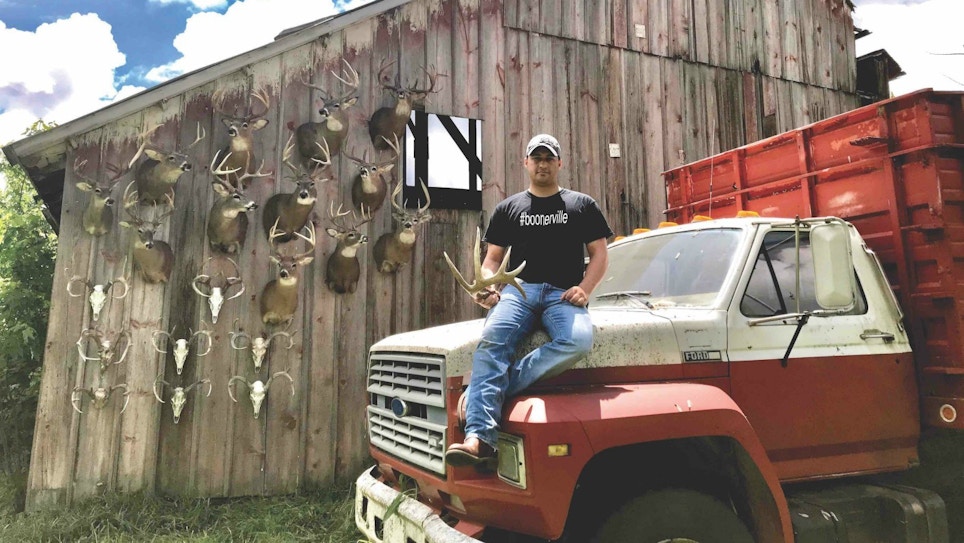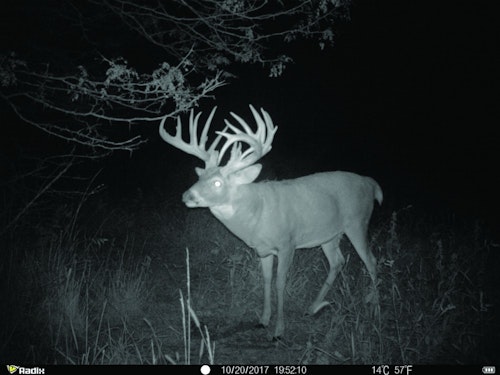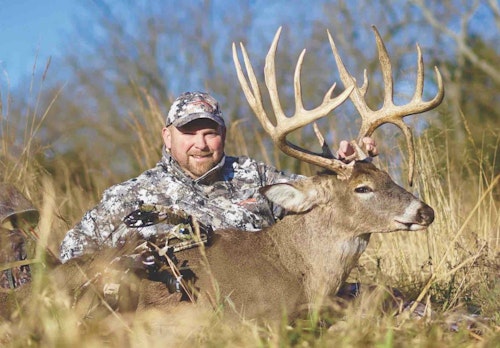
Moving states for whitetails has given Jordan Howell the opportunity to consistently shed hunt, scout, photograph and pursue trophy-caliber Iowa bucks.
Jordan Howell is chasing a legitimate 230-inch whitetail. While many may claim they too are chasing a 200-inch buck, Howell has the trail camera pictures to prove it. In his pursuit, he has passed on the opportunity to shoot several “Booners.” In fact, last year he had more than 30 bucks pass by his stand in one day, all captured on film. Six carried racks of at least 150 inches, but Howell elected to pass them all. He wants a world-class giant.
Howell’s trail cameras, scouting efforts and shed excursions are all filled with giant antlers. He picked up 100-plus sheds last spring while searching for a monster. So, he isn’t about to fill a whitetail tag prematurely, hoping for his chance at a world-class buck. Howell’s hunting situation may sound like a fantasy, unrealistic for most of us, but it doesn’t have to be.
Just over a decade ago, Howell was living in North Carolina, lucky to see 120-inch bucks on stand. In the winter of 2006, he climbed out of his stand, filled with disappointment as another season came to a close with zero encounters with bucks of the caliber he wanted to shoot. Truly passionate about hunting big whitetail bucks, Howell vowed to work to give himself the best possible chance at truly giant bucks one day.
A decade later, Howell now resides in southern Iowa, pursuing the biggest whitetail bucks possible. He strives to improve his chances of killing a world-class whitetail on a daily basis. To date, he has been successful chasing big bucks. The first year Jordan moved to Iowa, he killed 165-inch, 159-inch and 150-inch bucks, and has now raised the bar to the point he is regularly passing up this caliber of animal in pursuit of a true giant.
Howell’s desire to hunt big deer on a regular basis has come to fruition and so can yours, but it takes great sacrifice. Like Howell, Would you be willing to move states specifically to chase giant whitetails?
Taking the Plunge
Some people have the means to purchase their own property in which they can manage specifically for sustaining more whitetails and bigger bucks. This strategy of buying land and managing it for mature bucks has gained popularity during the past decade. But, what about the guy who cannot afford a land purchase and just wants to hunt where he can get access to great properties just by knocking on a few doors and hunting public ground?
There are relatively few places you can experience phenomenal whitetail hunting by knocking on doors or targeting public ground. However, there are pockets of whitetail habitat that still harbor the right ingredients and where hunting pressure is low enough that big bucks exist in quantity. If you would be willing to make the move, what factors should you consider before making the plunge? Here are a few to consider.

Quantity of Trophy-Class Bucks
If you are seriously considering moving just to hunt whitetails, you are in the minority. You’re a diehard whitetail fanatic that lives and breathes big antlers. You are likely not content with chasing 130-class deer, but looking for, at least, 150-inch bucks to chase on a consistent basis.
You can look at Boone and Crockett data to help pinpoint the states and counties that the most record book bucks have been harvested and entered into the books. However, just because these counties have the most Boone and Crockett entries doesn’t necessarily mean these counties are where the most have been shot. Buffalo County, Wisconsin dominates the list with a whopping 22 entries in the last 5 years. Texas certainly appears to be pumping out the giant bucks as well.
Although Boone and Crockett data is certainly helpful to consider, there are social norms in specific areas where entering bucks into the record books is more common than in other areas. For example, several Wisconsin hunters suggested that the high number of outfitters in Buffalo County probably adds to the likelihood of an individual submitting a buck to the record books. Additionally, Wisconsin hunters seem to be more likely to enter bucks into the record book than some other states. Kansas hunters have a different trend. A little digging provided anecdotal data that suggests Kansas hunters who have harvested multiple Boone and Crockett-caliber bucks, and knew of others who had as well, but chose not to enter a single buck into the record books.
The list of counties with at least five non-typical B&C entries in the previous 5 years may be a little more helpful to consider. These are certainly where the mega giants are dropping. Counties in Iowa, Ohio and Kansas top the list, each pumping out recent world-class bucks.
Hunting Pressure
A secondary factor to consider is likely the most important — and unfortunately, the most difficult factor to gauge — the amount of hunting pressure and opportunity to gain hunting access. Typically, the best way to assess hunting access is to physically go to that area and spend a day knocking on doors asking for permission to hunt.
However, getting a rough estimate of hunting pressure is more difficult. From the convenience of your home, you can look at a county’s population density provided by the United States Department of Agriculture. This will at least allow you to compare the density of one county’s population to another. Typically, a denser population correlates with more hunters in the woods. The chart below indicates human densities of six Boone and Crockett whitetail hotspots.
Another great resource for gauging hunting pressure is local land realtors. Call a land realtor in a specific area to discuss recreational land and the amount of deer hunters in the area. Often, you can get a general feel for the amount of hunting pressure in a particular region.

Hunting Regulations
A state’s hunting regulations and how that state has historically made whitetail management decisions should certainly factor into your location of choice. How many bucks can you harvest in that state? How easily can a nonresident get a deer license? Does the quality of whitetail trophy hunting seem to be on the rise or the decline? How does the state handle CWD and other diseases? Can you use feed or minerals throughout the year?
All of these questions, and more, should be carefully considered and weighed in decision-making. Illinois does not allow baiting at any time of year, even in the summer months when an inventory of bucks is best taken on mineral sites. Kansas allows baiting all year, but only allows one buck tag per individual. Wisconsin has had CWD for decades, in which an area’s deer herd can be seemingly decimated by sharp shooters overnight and property values plummet. Each state’s hunting regulations can dramatically change its appeal.
Other Real-Life Examples
Donnie Monroe, now a resident of Kansas, grew up in central Indiana. His passion for whitetails led him to move to what he describes as a “night and day difference” in the quantity and quality of trophy-caliber animals he regularly sees. Monroe moved to Kansas 3 years ago and has taken a bigger buck every year he has been there. In 2016 he harvested a 152-inch deer, in 2017 a 172-inch brute, and in 2018 a monster 209-inch buck he named “Pinhead,” after watching him for three seasons. Monroe said having the capability of chasing and taking deer the caliber of Pinhead simply was not a possibility before he moved to this new whitetail mecca. He’s already set his sights on another giant for this upcoming fall. “There was certainly great sacrifice in moving my family, but it has been well worth it,” he said.
Scott Buckley, who now calls southern Iowa home, remembers taking “A long, careful look at every statistic I could find,” as he was contemplating where he wanted his next residence to be. But at the end of the day, Buckley said he knew southern Iowa was simply the best trophy-class whitetail area in the world. He has consistently taken giants on public land since he moved to Iowa in 2009. There, he has taken 10 bucks on public ground averaging around the 160-inch mark, and three bucks off his own 240-acre farm. Scott said moving specifically for whitetails was always a dream of his. Now, chasing trophy-class animals on public ground is a dream come true.

Conclusion
At the end of the day, moving states specifically to chase your dream of the best whitetail hunting possible requires great sacrifice. In making a decision, you will need to pour over the data and statistics to narrow your search, but nothing can replace traveling to an area and experiencing a whitetail habitat first-hand. Making a move for whitetails will likely involve a new job, new friends, a new house and simply a whole new life. Yet, at the end of the day, isn’t chasing dreams what life is all about? There’s a select few passionate whitetail fanatics out there who have made the jump. Consider these factors to help get your search started if a big move is in your future.
Sidebar: Most B&C Entries in Previous 5 Years by County
(Source: www.boone-crockett.org)
- Buffalo County, Wisconsin, 22
- Webb County, Texas, 18
- Maverick County, Texas, 18
- La Salle County, Texas, 15
- Otter Tail County, Minnesota, 13
- Dimmit County, Texas, 13
- Adams County, Ohio, 12
- Crawford County, Wisconsin, 12
- Warren County, Iowa, 11
- Richland County, Wisconsin, 11
Counties With at Least 5 Non-Typical B&C Entries in Previous 5 Years
- Warren County, Iowa, 8
- Adams County, Ohio, 7
- Pottawatomie County, Kansas, 6
- Otter Tail County, Minnesota, 6
- Licking County, Ohio, 6
- La Salle County, Texas, 6
- Lucas County, Iowa, 5
- Reno County, Kansas, 5
- Riley County, Kansas, 5
- Hughes County, Oklahoma, 5
- Todd County, Kentucky, 5
- Dodge County, Wisconsin, 5
- Kleberg County, Texas, 5
- Todd County, Minnesota, 5
- Becker County, Minnesota, 5
Sidebar: Land Values
Farmland values may also be something to consider if you are looking to purchase acreage when you move. Land values are typically higher when a region has fertile soils that could be used for agricultural row crops. (Source: www.acrevalue.com)
- Warren County, Iowa, $7,560/ac
- Adams County, Ohio, $3,976/ac
- Pottawatomie County, Kansas, $3,226/ac
- Otter Tail County, Minnesota, $4,426/ac
- Buffalo County, Wisconsin, $5,848/ac
- Webb County, Texas, $3,318/ac





